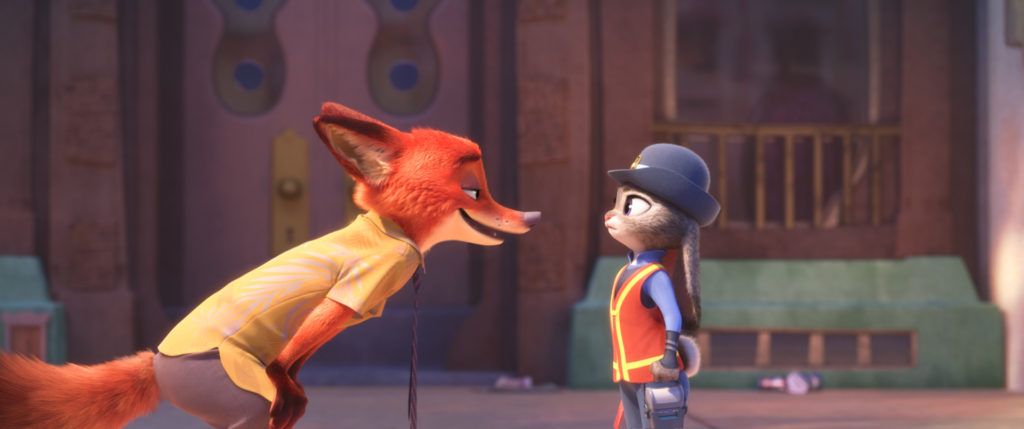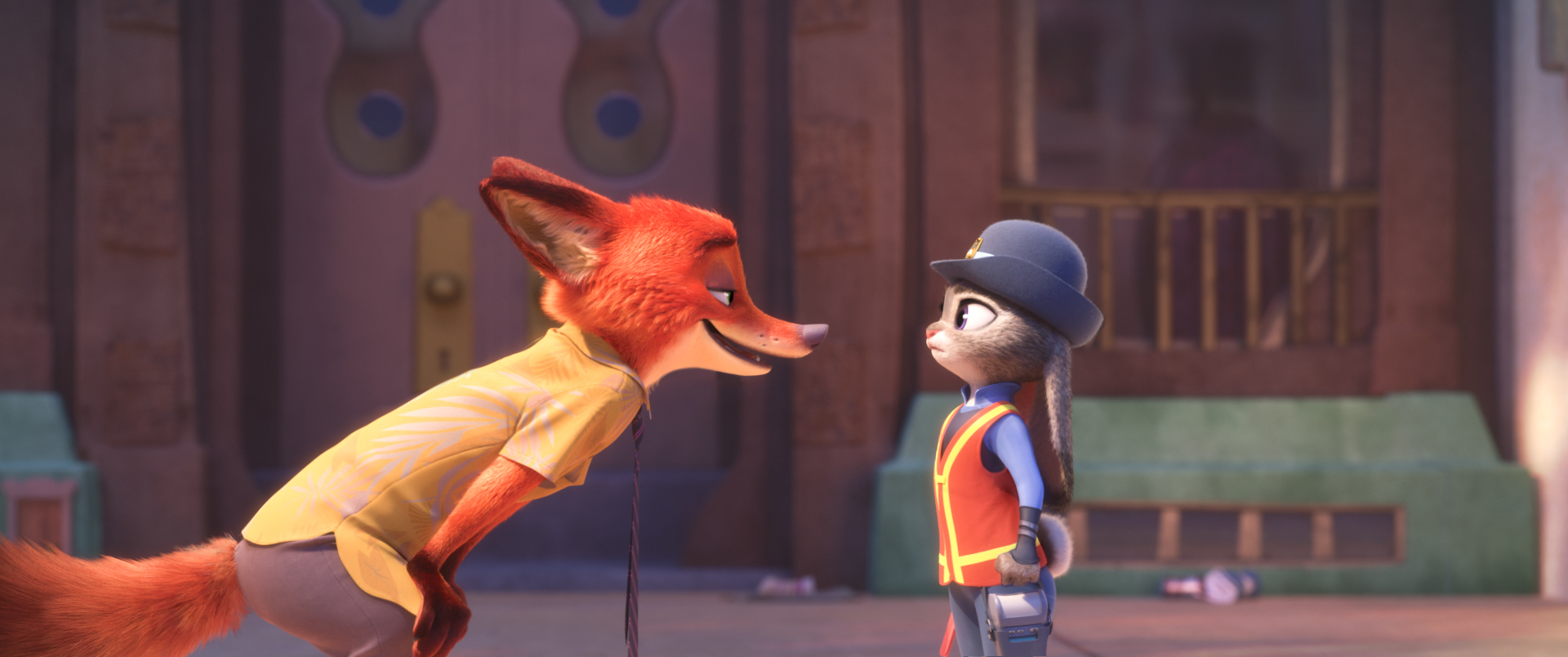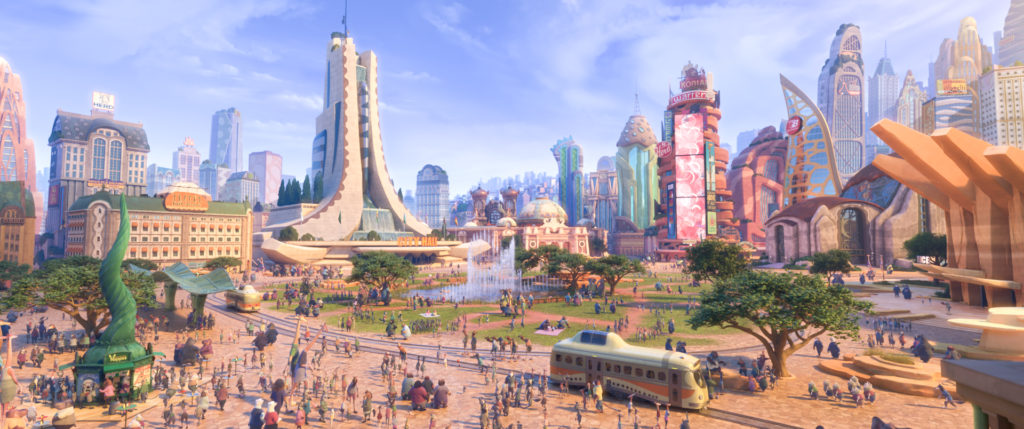SALT LAKE CITY — Disney’s “Zootopia” is hitting theaters today, much to the delight of critics and audiences around the country.
Currently sitting at an impressive 99 percent on RottenTomatoes.com and, having earned a great review here at KSL.com, the film is being hailed as one of the studio’s best computer generated offerings to date.
We got the chance to sit down with the directors of the film, Byron Howard and Rich Moore, to talk “Zootopia” and the creative process at Disney animation.
The interview:
Travis Poppleton: Most movies, you start with one director who’s, you know, necessarily tyrannical. (laughter)
Rich Moore: Now you have two that are tyrannical.
Poppleton: Exactly, so, my first question is: Are you still friends?
Moore: No (laughing).
Poppleton: How do you do that? How do you divide and conquer?
Byron Howard: Oh yeah. I actually think these movies are great because I’ve made two other movies at Disney with directing partners, and I knew Rich socially before we made this movie together. We are both part of the Story Trust, which is a group of directors and heads of stories, but we hadn’t really worked together.
Rich was very kind too, he dropped what he was doing about a year and a half before this film had to be done and he came on to direct this film with me. What’s nice about working with other directors on these films is you become much closer as friends. We spend more time with each other than we do our own families, and we get to learn more about what makes each other tick. It’s a great way to have someone else who, through every situation, is there for you to kind of bounce ideas off of, and so we can do gut checks with each other. I think we know much more about each other than we ever did before.
Moore: Yeah. I think that too.
Byron Howard: From the beginning we were of the same mind of what the movie was wanting to be and where we wanted to take it, and we never had anything where-
Moore: No. Like, “No it’s got to be this way.” (laughing).
Howard: I think because we in general at Disney, nowadays, since John and Ed kind of came in and reset the whole place in a very, very good way. We’re very cooperative, and it’s not like auteur filmmaking at all.
Moore: That’s the thing.
Howard: It’s teams of people.
Moore: It’s not — there really aren’t any tyrants or dictators in animation.
Howard: No, we got rid of those guys (laughing).
Moore: It’s so collaborative; if you can’t work with people then I don’t know how someone would survive. If they were just always bossing people around.
I mean it’s just way too many decisions. I like to be surprised. I like putting something before an artist and say, this is the vision for this and then having that person add their layer of what they do well. Stepping back and thinking, oh my God, I would not have thought of that.
It’s not exactly what I was thinking, but that is so cool.
Howard: Yeah.
Moore: I probably would not have thought of that right off the cuff, but I like those kinds of moments.
Howard: Yeah. We were talking about this earlier too. The one thing a director in animation can do that is the worst possible thing, is to be so tunnel vision and single-minded about what he or she thinks the answer is.
Anytime you do that, you shut down this information that’s coming from outside, these ideas coming inside. That’s a sure way to fail I think.
Moore: Yeah, that’s that kind of bunker mentality of, no I don’t want to hear anyone else you know, I know what it is.
I’ve seen a lot of people that kind of go down in flames thinking that way.
Poppleton: It seems like on every level of the process you’re working with people who are so creative.
Moore: Right. Look I’ve never worked in live-action, and you hear stories of people that are like that.
I don’t know what it is about the two different mediums that would allow someone to be able to be like that and still work with people, but I think we have to work with so many people, intimately, that if we’re to act like a dictator then the movie’s going to suffer.

NATURAL ENEMIES — Zootopia’s first bunny officer Judy Hopps finds herself face to face with a fast-talking, scam-artist fox in Walt Disney Animation Studios’ “Zootopia.” Featuring the voices of Ginnifer Goodwin as Judy and Jason Bateman as Nick, “Zootopia” opens in theaters on March 4, 2016. ©2016 Disney. All Rights Reserved.
Poppleton: When do you come in on the story? How far is the story along when the two of you start tackling a project like “Zootopia”? Is it already written?
Howard: Oh no, it begins with us. That’s the cool thing about being an animation director is that you do get to start when it’s this notion. A little spark of something that people are lighting up to, and then you get to watch it grow along the way. I think that getting back to that sort of collaboration idea, whereas it usually starts with one or two people, maybe a writer and a director or a head of story and then the team grows over a period of years to where maybe a couple years into it then you’re actually diving into script and production and once you get sort of the green light to go ahead, then it really gets legs under it and it really goes.
That’s the cool thing; again I don’t know that a lot of live-action directors have that luxury to see something grow from the beginning. Even the two previous films that I did. I came in after the films had sort of blown up, in both cases, and I was coming on with a new crew of people. The films had sort of existed in some form before, so this is the first one for me where I sort of got to see it through from the beginning.
Moore: It’s different from live-action, it doesn’t start with a producer buying a property or working with a writer to create a script and then the director comes in. The stories do begin with the directors at our studio.
Poppleton: I’m glad you said that, because I went into this movie having a very definite idea of what it was.
Howard: Oh yeah.
Poppleton: But what it turned out to be was a story that deals with complicated and really kind of charged themes, and themes people are talking a lot about today. And it made me wonder, do you start with that theme and you’re saying to yourself we’ve got to get in on this conversation, or does a movie like this being with the story and at some point you say, oh you know what theme would work with this?
Moore: The process is different from movie to movie. I have found that if you try to start with a theme and be too slavish to it that that can really make building the story difficult. You know?
I know our colleagues up at Pixar are kind of the same way; that it’s good to start with a theme but then be open to maybe allowing it to move a little bit. But you don’t want it to move so much that it’s not even what inspired you to begin pitching the story.
It is really like the old plate-spinning act from vaudeville. OK, we’ve got a theme going, we’ve got a world going, we have these characters and how each one is informing one another. Being too slavish to one might prevent the movie from really becoming something big and powerful.
Poppleton: Well, I love that it seems so simple. My 7-year-old daughter attended the screening with me, and I don’t think she was readily aware of the themes. But as an adult, the whole time my mind was making connections, and I think you balanced your audience and executed this so well.
Howard: Oh thank you, and you know it’s funny because all the stuff about stereotype and these two different groups didn’t come along, it came from research. We did a lot of research into the mammal world, especially we found that mammals, it’s true we say it in the movie, that 90 percent of them are prey animals and 10 percent are predators. Automatically we had this great fact about reality, where you have these two imbalanced groups that don’t always see eye to eye. Really juicy.
You uncover these nuggets of gold.
We didn’t really commit to that. We said, well that’s a difficult thing to talk about but how can we do it through the characters and how can we do it right. None of us like preachy movies, or movies that tell you what to think. We thought, OK we can tell the story in a sensitive way through the journey of the characters.
Especially with Judy, because she seems like a typical Disney character when you first meet her. She seems like, I’m driven, I’m going to go live my dream, very bright-eyed and wide-eyed, then it’s only as you see how she handles herself through this very difficult situation. Even looking at herself and realizing I’m flawed I have a blind spot that I didn’t think was there, I thought this was an issue with my parents, but I have it too. The fact that she actually steps up and, as an adult, owns it is a pretty mature choice for a character.
That’s why Ginnifer was so great. She sounds like the Disney ideal heroine, but there’s that fire and that commitment to becoming a better person that really submits her into a very layered character.
Poppleton: On that topic, and I’ll try to word this in a way where I don’t spoil this, but the place that I think was most powerful to me and seems to fit in with what you’re saying, is what you do with the bully at the beginning of the movie. I, of course, had my expectations of where the character was headed but when I saw what you did with him, I got a bit choked up. I think it was just such a great decision.
Moore: To have him come back in the story and see that he’s a changed person, that he’s not the same person he was as a child and that he had changed. As we were doing it that’s when I knew, OK we’re digging in deep here. We’re getting away from the clichés and that was always our goal. We don’t want this to just be kind of morality-town and Judy’s a really perfect person who teaches everyone it’s not nice to put people in boxes. We wanted her to really be the one that realized like, oh my God, I’m just like everyone else.
Howard: I think all of us had experiences with bullies when we were growing up and one of the things that ultimately made me feel better about what I was experiencing, I remember thinking this as a child, one of the kids who was beating me up, I became aware that in his own home he was being beat up. He had a very bad parental situation, and I think that made me feel like I understood where this kid, Eric, was coming from and I had, all of a sudden, great compassion.
Where I was afraid and angry at this kid, all of a sudden, my heart kind of went out to him because I had a good home. I had parents who loved me, and I think that’s the complexity that is sometimes lost when you don’t know how to deal with that kind of thing. Bullies are complex and sort of people putting you in boxes and misjudging you, it’s a complex issue because there are many, many things that are working on people that you don’t really realize are there until you get to know them.
That’s when Judy and Hopps really connect. There’s something that’s very similar about them, their upbringing. Nick had this hope to be like Judy and make a difference to the world when he was a kid, but through that experience those hopes were crushed and he said I’m going to protect myself and he shut down.
Howard: Exactly. The fact that he now opens up because of this rabbit, who is the complete opposite of anyone he’d want to hang out with, in the beginning of the movie. Now they’ve bonded over this very, very important thing.
We talk a lot, you can tell, we do this exactly like we’re doing it with you in the story room.
(laughter)
We talk about our experiences. We open up and it’s like a therapy session for a couple years, so we get to know each other very well. That’s where a lot of these layers come from.
Poppleton: Just one last question. The design was gorgeous, just a beautiful, beautiful film to look at, and I noticed a lot of classic Disney designs.
I don’t know if you’re pulling from like Br’er Fox and Thumper, but they had that classic Disney –
Howard: Oh yeah, that was very intentional. We looked back. We have to credit our art director Dave Getz and Matthias Lechner who designed the city, and Cory Loftis who did all the character work on the film. We have an amazing legacy of Disney animal films, all Disney animation’s classic, but we have this great tradition of Disney character design that has such appeal to it. Cory, I’ve got to say, did a great job and looking back at what makes Disney animals specifically. Amazing. So he looked back at the peak of that, which is “Robin Hood” and “Bed knobs and Broomsticks.” Or he even liked the stuff from “Mary Poppins,” those animated segments, and brought that into the 3-D world. Now that fact that we can actually put distinct fur on six single different species of characters and dress them in clothes and make color variants and populate the world with 100,000 characters, where 2 years ago we couldn’t have made this movie.
Moore: Yeah, it would’ve been impossible.
Howard: It’s very intentional, but we work with the best artists in the world. That’s no joke. That’s not hyperbole. We’re really proud of the people we work with, and we couldn’t be more proud of them.
Poppleton: Well, I loved it. I know that you couldn’t have done this in 2-D, but I have to say I do miss 2-D.
Howard: I know, we do. It would’ve been a different movie. There will be a film where that comes in, I think.
Conclusion:
There was one last question we snuck in at the end, which because it spoils a small part of the movie we decided not to include. We’ll sum up the answer here by noting, Howard and Moore didn’t take any decision about their story lightly, even when it was about something as seemingly simple as the color blue.
If it wasn’t already obvious, both men were super nice and seemed genuinely happy to be talking about their creation, even though we were probably their 120th interview for the day.
If you’re looking for something to do with the family this weekend, “Zootopia” is a pretty fantastic option, and is rated PG for some thematic elements, rude humor and action.
Originally published KSL.com


